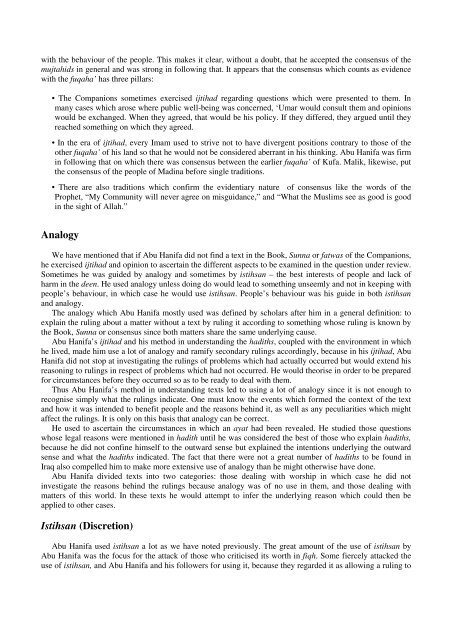Create successful ePaper yourself
Turn your PDF publications into a flip-book with our unique Google optimized e-Paper software.
with the behaviour of the people. This makes it clear, without a doubt, that he accepted the consensus of the<br />
mujtahids in general <strong>and</strong> was strong in following that. It appears that the consensus which counts as evidence<br />
with the fuqaha’ has three pillars:<br />
• The Companions sometimes exercised ijtihad regarding questions which were presented to them. In<br />
many cases which arose where public well-being was concerned, ‘Umar would consult them <strong>and</strong> opinions<br />
would be exchanged. When they agreed, that would be his policy. If they differed, they argued until they<br />
reached something on which they agreed.<br />
• In the era of ijtihad, every <strong>Imam</strong> used to strive not to have divergent positions contrary to those of the<br />
other fuqaha’ of his l<strong>and</strong> so that he would not be considered aberrant in his thinking. <strong>Abu</strong> <strong>Hanifa</strong> was firm<br />
in following that on which there was consensus between the earlier fuqaha’ of Kufa. Malik, likewise, put<br />
the consensus of the people of Madina before single traditions.<br />
• There are also traditions which confirm the evidentiary nature of consensus like the words of the<br />
Prophet, “My Community will never agree on misguidance,” <strong>and</strong> “What the Muslims see as good is good<br />
in the sight of Allah.”<br />
Analogy<br />
We have mentioned that if <strong>Abu</strong> <strong>Hanifa</strong> did not find a text in the Book, Sunna or fatwas of the Companions,<br />
he exercised ijtihad <strong>and</strong> opinion to ascertain the different aspects to be examined in the question under review.<br />
Sometimes he was guided by analogy <strong>and</strong> sometimes by istihsan – the best interests of people <strong>and</strong> lack of<br />
harm in the deen. He used analogy unless doing do would lead to something unseemly <strong>and</strong> not in keeping with<br />
people’s behaviour, in which case he would use istihsan. People’s behaviour was his guide in both istihsan<br />
<strong>and</strong> analogy.<br />
The analogy which <strong>Abu</strong> <strong>Hanifa</strong> mostly used was defined by scholars after him in a general definition: to<br />
explain the ruling about a matter without a text by ruling it according to something whose ruling is known by<br />
the Book, Sunna or consensus since both matters share the same underlying cause.<br />
<strong>Abu</strong> <strong>Hanifa</strong>’s ijtihad <strong>and</strong> his method in underst<strong>and</strong>ing the hadiths, coupled with the environment in which<br />
he lived, made him use a lot of analogy <strong>and</strong> ramify secondary rulings accordingly, because in his ijtihad, <strong>Abu</strong><br />
<strong>Hanifa</strong> did not stop at investigating the rulings of problems which had actually occurred but would extend his<br />
reasoning to rulings in respect of problems which had not occurred. He would theorise in order to be prepared<br />
for circumstances before they occurred so as to be ready to deal with them.<br />
Thus <strong>Abu</strong> <strong>Hanifa</strong>’s method in underst<strong>and</strong>ing texts led to using a lot of analogy since it is not enough to<br />
recognise simply what the rulings indicate. One must know the events which formed the context of the text<br />
<strong>and</strong> how it was intended to benefit people <strong>and</strong> the reasons behind it, as well as any peculiarities which might<br />
affect the rulings. It is only on this basis that analogy can be correct.<br />
He used to ascertain the circumstances in which an ayat had been revealed. He studied those questions<br />
whose legal reasons were mentioned in hadith until he was considered the best of those who explain hadiths,<br />
because he did not confine himself to the outward sense but explained the intentions underlying the outward<br />
sense <strong>and</strong> what the hadiths indicated. The fact that there were not a great number of hadiths to be found in<br />
Iraq also compelled him to make more extensive use of analogy than he might otherwise have done.<br />
<strong>Abu</strong> <strong>Hanifa</strong> divided texts into two categories: those dealing with worship in which case he did not<br />
investigate the reasons behind the rulings because analogy was of no use in them, <strong>and</strong> those dealing with<br />
matters of this world. In these texts he would attempt to infer the underlying reason which could then be<br />
applied to other cases.<br />
Istihsan (Discretion)<br />
<strong>Abu</strong> <strong>Hanifa</strong> used istihsan a lot as we have noted previously. The great amount of the use of istihsan by<br />
<strong>Abu</strong> <strong>Hanifa</strong> was the focus for the attack of those who criticised its worth in fiqh. Some fiercely attacked the<br />
use of istihsan, <strong>and</strong> <strong>Abu</strong> <strong>Hanifa</strong> <strong>and</strong> his followers for using it, because they regarded it as allowing a ruling to














